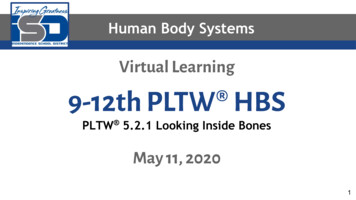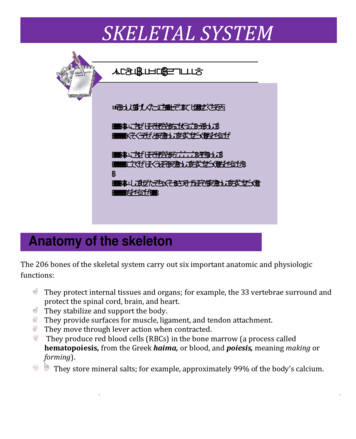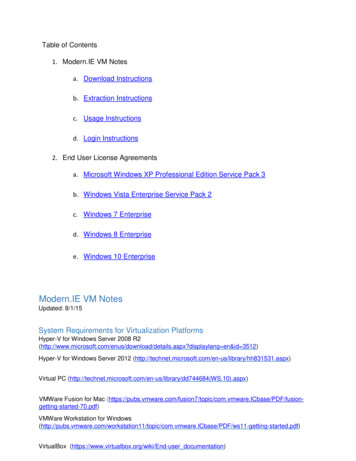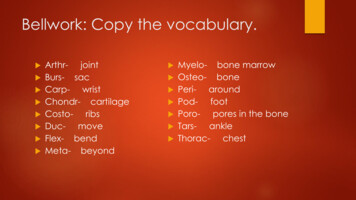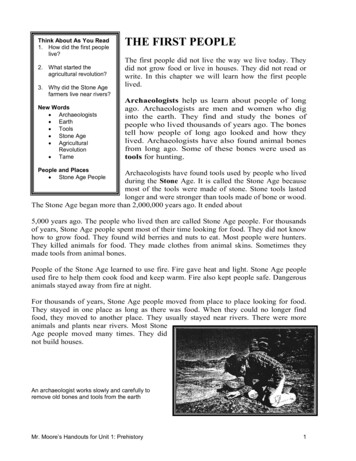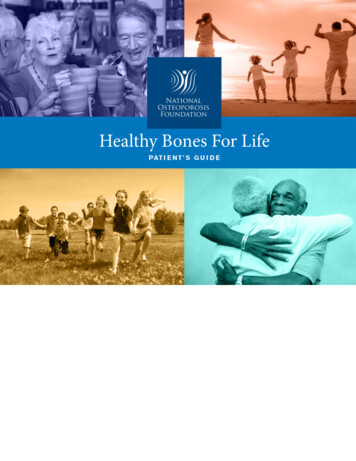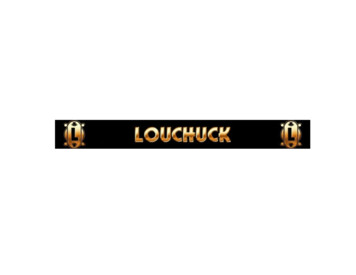
Transcription
Bones and Muscles:An Illustrated AnatomyWritten and Illustrated byVirginia Cantarella
Bones and Muscles: An Illustrated AnatomyTable of ContentsAcknowledgements3Introduction4List of Illustrations5List of Terms10Head and Neck11Shoulder46Arm and Hand56Back and Thorax97Abdomen and Pelvis121Leg and Foot1422
Bones and Muscles: An Illustrated AnatomyAcknowledgementsCopyright 1999 Virginia CantarellaPublished by Wolf Fly Press, South Westerlo, New YorkThere are many people to whom I feel deep gratitude forhelping me realize this book. First is Barbara Hollis, whoasked me to help her learn the muscles and their origins andinsertions as she was studying to become a massage therapist. I did drawings for her. While doing them, it occurred tome that one could make an illustrated book from which others might be able to learn. I am deeply grateful to MarilynHagberg, fellow artist and journalist, who spent months editing the text. Erica Manfred suggested to me that I self-publish this work as an ebook and introduced me to the peoplewho could help me learn how to do it. I am most grateful toDr. Greg La Trenta who went over all the artwork checking itfor accuracy. Thanks to Laurie Burke, who, by email andtelephone guided me in the making of this book. Thanks toour children who have helped, guided and encouraged me.Finally, there is my husband, Herman Shonbrun, whoencouraged me all the way and put up with my long hoursat the computer.All rights reserved. No part of this book may be reproduced,transmitted or stored in a retrieval system without the priorwritten consent of the publisher.For information on ordering this book contact the publisher at:Wolf Fly PressP.O. Box 719Greenville, New York 12083ginger@capital.netWritten and illustrationed by Virginia CantarellaDesign by Virginia Cantarella, PublisherEdited by Marilyn HagbergPDF production by Subtext Communications3
An Illustrated Anatomy: Bones and MusclesBones and Muscles: An Illustrated AnatomyBones and Muscles: An Illustrated Anatomy is designed for professionals who work with the body—for physical therapistsand massage therapists, as well as for students, professors ofanatomy, and physicians. People who are interested in aerobics, dance, or sports and are interested in their musculaturewill find this book informative. Additionally, artists interested in drawing the figure would benefit from studying it.and R.M. H. McMinn and R. T. Hutching’s Color Atlas ofHuman Anatomy and finally Werner Spalteholz’s Hand Atlas ofHuman Anatomy. I have also worked from my own drawingsdone from dissections. I have done the skeleton drawings frommy own skulls, backbone and pelvis, other bones loaned byfriends, and from whole skeletons owned by acquaintances.Going from the top to the bottom—from head to toe—Ishall illustrate all of our bones and voluntary muscles. Foreach part of the body I illustrate the bones involved, andwith drawings and text show how and where the musclesattach to them.In making my drawings I have referred to Gray’s Anatomy,long considered the definitive anatomy book, Frank Netter’sAtlas of Human Anatomy, Grant’s Atlas of Anatomy, CarmineD. Clemente’s Anatomy—A Regional Atlas of the Human Body,4
Bones and Muscles: An Illustrated AnatomyList of Illustrations1The skull from a 3 4 frontal viewp.1215The digastric musclep.302The skull seen from the sidep.1416The styloid musclep.313The frontalis and the occipital musclesp.1517The mylohyoid musclep.324The corrugator supercilii and the procerus musclesp.1718The goniohyoid musclep.335The palpebral levator superioris musclep.18196The orbicularis oculi musclep.19The thyrohyoid muscleThe sternothyroid musclep.347The auricularis musclesp.2020The sternohyoid and omohyoid musclep358The nasalis muscleThe depressor septi muscle21The bones of the neck, interior-frontal viewp.3622The skull, neck and upper back, posterior viewp.3723The sternocleidomastoid musclep.3824The rectus capitis lateralis musclesThe rectus capitis anterior musclesp.39The rectus capitis posterior minor muscleThe rectus capitis posterior major muscleThe obliquus capitis superior muscleThe obliquus capitis inferior musclep.4026The scalenus musclesp.4227The longus colli muscleThe longus capitis musclep.43910The orbicularis oris muscleThe buccinator muscleThe levator anguli oris musclep.21p.22The zygomaticus major muscleThe zygomaticus minor muscleThe levator labii superioris muscleThe levator anguli oris muscleThe levator labii superioris alaeque nasi muscleThe depressor anguli oris muscleThe deppressor labii inferioris muscleThe mentalis muscleThe risorious musclep.2411The temporalis musclep.2628The platysma musclep.4512The masseter musclep.2729The bones of the shoulder, anterior viewp.4713The pterygoid musclesp.2830The bones of the shoulder posterior viewp.4814The bones of the neckp.29255
Bones and Muscles: An Illustrated Anatomy313233The levator scapulaeThe rhomboideus major musclep.49The teres minor muscleThe teres major musclep.5147The flexor pollicis longus musclep.6948The flexor digitorum profundus musclep.7149The flexor digitorum superficialis musclep.7250The flexor carpi ulnaris muscle, anterior andposterior viewsp.73The supraspinatus muscleThe infraspinatus musclep.5234The subscapularis musclep.5351The palmaris longus musclep.7435The deltoid musclep.5452The flexor carpi radialis musclep.7536The trapezius musclep.5553The abductor pollicis longus musclep.7637The bones of the right arm and hand with shoulderand two ribs, anterior view;The same bones without the ribs, posterior view54The extensor pollicis brevis musclep.7755The extensor pollicis longus musclep.7856The extensor indicis musclep.7938p.57The humerus, the clavicle, the rib cagethe sternum,and the scapula: anterior viewp.5857The brachioradialis musclep.8039The pectoralis major musclep.6058The extensor carpi radialis longus musclep.8140The latissimus dorsi musclep.615941The corocobrachialis muscleThe brachialis muscleThe extensor carpi ulnaris muscleThe extensor carpi radialis brevis musclep.82p.626042The biceps brachii musclep.63The extensor digitorum muscleThe extensor digiti minimi musclep.834344The triceps brachii muscleThe elbow and forearm from the palmer viewThe elbow and forearm from the dorsal viewp.6461The bones of the right hand and wrist, palmar viewp.8562The bones of the hand, dorsal viewp.8663The dorsal interossei musclesp.8764The interossei palmares musclesp.884546p.65The pronator teres muscleThe pronator quadratus muscleThe supinator musclep.6665The lumbricales muscles of the handp.89Anconeus musclep.6866The opponens digiti minimi musclep.906
Bones and Muscles: An Illustrated Anatomy67The flexor digiti minimi brevis musclep.9168The abductor digiti minimi musclep.9269The adductor pollicis musclep.9370The opponens pollicis muscleThe palmaris brevis musclep.9471The flexor pollicis brevis musclep.9572The abductor pollicis brevis muscle73The ribcage and the spinal column, showing the sixthcervical vertebra, the twelve thoracic vertebrae,and the first lumbar vertebrae, posterior viewp.112The rib cage or thorax with the twelve thoracicvertebrae, left lateral viewp.11386The transverse thoracic musclep.114p.968788The intercostales interni musclesThe intercostales externi musclesp.115p.116The bones of the backp.9789The serratus anterior musclep.11774Three views of the tenth and eleventh thoracic vertebraep.9990The serratus posterior muscles, superior and inferiorp.11875The splenius capitis muscleThe splenius cervicis musclep.10191The levatores costorum musclesp.11992The pectoralis minor muscleThe subclavius musclep.120The torso from a three quarter front view;the ribcage with the sternum, scapula and humerus;the spinal column with the sacrum, showing how itarticulates with the pelvis;the top of the femur, showing how it articulates withthe pelvisp.12294The torso seen from the sidep.12395The rectus abdominis musclep.124768485The transversospinales musclesThe rototores brevis and the rotatores longus musclesThe intertransversarii musclesThe interspinales musclesp. 10277The multifidus musclep. 10478The semispinales musclesp. 10579The spinales musclesp. 10680The longissimus dorsi musclep.10781The iliocostalis musclep.10996The transversus abdominis musclep.12682The thorax or rib cagep.11097The obliquus internus abdominis musclep.12783The sternum, the costal cartilages and part of ten ribs,ventral viewp.11198The obliquus externus abdominis musclep.12899The quadratus lumborum musclep.129937
Bones and Muscles: An Illustrated Anatomy100 The pelvis, anterior viewp.131115 The gracilis musclep.148101 The right innominate bone, lateral viewThe right innominate bone, medial viewp.132116 The vastus intermediusThe vastus lateralisThe vastus medialis musclesp.149117 The rectus femoris musclep.151118 The sartorius musclep.152119 The tensor fasciae latae musclep.153120 The biceps femoris musclep.154121 The semitendinosus musclep.155122 The semimembranosus musclep.156123 The bones of the lower leg, anterior andposterior viewsp.158102 The pelvis, posterior inferior view, showing the headof the femur in the acetabum;The pelvis, anterior inferior view, showing the topportion of the femur with its head in the acetabulump.133103 The psoas major muscleThe psoas minor muscleThe iliacus musclep.134104 The obturator externus musclep.136105 The obturator internus muscleThe gemellus muscle, superior and inferiorThe quadratus femoris muscleThe piriformis musclep.137124 The popliteus musclep.160106 The gluteus minimus musclep.139125 The plantaris musclep.161107 The gluteus medius musclep.140108 The gluteus maximus musclep.141126 The extensor digitorum longus muscleThe fibula tertius musclep.163127 The flexor hallucis longus musclep.165109 The bones of the right leg and pelvis, anterior andposterior viewsp.142128 The tibialis anteriore musclep.166110 The bones of the right thigh, anterior andposterior viewsp.143129 The peroneus (fibula) brevis muscleThe peroneus (fibula) longus musclep.167111 The adductor magnus and adductor minimus musclep.144130 The tibialis posteriore musclep.169112 The adductor brevis musclep.145131 The flexor hallucis longus musclep.170113 The adductor longus musclep.146132 The flexor digitorum longus musclep.171114 The pectineus musclep.1478
Bones and Muscles: An Illustrated Anatomy133 The medial and lateral aspect of the foot showing thetendinous extensions of all the flexor and extensormuscles on the lower leg which control the movementof the foot and ankle and the retinaculae which keepthem in placep.172134 The soleus musclep.173135 The gastrocnemius musclep.174136 The bones of the foot, dorsal viewp.176137 The bones of the foot, plantar viewp.177138 The bones of the foot, medial viewThe bones of the foot lateral viewp.178139 The dorsal interossei musclesp.179140 The extensor digitorum brevis musclep.180141 The plantar interossei musclesp.181142 The flexor hallucis brevis muscleThe flexor digiti minimi brevis musclep.182143 The adductor hallucis musclep.183144 The lumbricale musclesThe quadratus plantae musclep.185145 The abductor hallucis muscleThe abductor digiti minimi musclep.187146 The flexor digitorum brevis musclep.1889
Bones and Muscles: An Illustrated AnatomyList of TermsTERMS DESCRIBING POSITIONSTERMS DESCRIBING MUSCLESSuperior: aboveBelly: the body of the muscle, the fattest partInferior: belowHeads: Some muscles arise as two or more bodies and mergeinto one tendon. The bodies are called heads.Lateral: to the outsideMedial: toward the middleTERMS DESCRIBING BONESAnterior: in frontPosterior: in backForamen: a small opening or holeNasal: toward the noseFossa: a cavityVentral: on the side of the stomachProcess: a projection or outgrowth from a larger structureDorsal: on the side of the backTubercle, tuberosity: a rough rounded prominence orCaudal: at or near the tail, or where the tail would beElevation: (not as big as a process)Superficial: outermost layerTERMS DESCRIBING MOVEMENTAbduction: a moving away from the body or the median axisAdduction: a moving toward the body or the median axisExtension: the straightening of a limb or body partFlexion: the bending of a limb or body partRotation: the turning of a limb or body part10
Bones and Muscles: An Illustrated AnatomyHead and NeckHEADThere are some features unique to the skull. The individualbones do not always dictate the larger shapes of the skull. Asuture, or meeting of two different bones, is found in themiddle of a larger form. You can see this meeting particularlyin the zygomatic arch as well as in the ocular orbit.The frontal bone, the ethmoid and the maxilla have withinthem empty spaces called sinuses. The ethmoid bone, if cutin half, looks like a cluster of bubbles, and the walls of thesinuses are almost as thin as the wall of a bubble and arevery fragile. If the skull were solid bone it would be so heavyyou wouldn’t be able to hold your head up. By having emptyspaces within the bones and therefore making them lighter,the sinuses are nature’s way of solving that problem. Theycan present other problems, however, for they are lined withmucous membranes that can become infected and getclogged up. Each sinus has a small opening into the nasalcavity which allows drainage.11
Bones and Muscles: An Illustrated AnatomyHead and Neck Illustration 1Parietal B.THE SKULL FROM A 3 4 FRONTAL VIEWFrontal B.The skull is made up of 19 bones, 12 of which are pairs. Youcan see most of these bones in the illustration. Where thebones join is called a suture. Little fingers of bone interdigitate with adjoining little fingers to make the joining solid.The bones shown are: the frontal bone, the nasal bones, thelacrimal bones, the ethmoid bones, the sphenoid bones, thezygomatic bones, the maxilla, the mandible, the parietalbones, the temporal bones, the occipital bone, the palatinebones (not seen, since they are inside the orbit of the eye),and the vomer (not seen, since it is inside the nasal cavity).Nasal B.FrontalprocessSphenoid B.Ethmoid B.Temporal B.Zygomatic B.Occipital B.MaxillaThere are two bones that you cannot see in the illustration,the palatine and the vomer. The palatine bones are pairedand are buried deep in the skull behind the nose. They makeup the rear part of the palate, part of the base of the nasalcavity, and a small part of the floor or the orbit. The vomer isa thin bone which forms part of the nasal septum separatingthe two sides of the nasal cavity.Mastoid ProcessRamusCoronoidProcessMandible Lacrimal, meaning tear producing, is from the Latin lachrymal, meaning a small vase, of the kind found in ancientRoman sepulchers that was used for collecting tears shed inTHE SKULL12 V.Cantarella
Bones and Muscles: An Illustrated Anatomymourning.(The lacrimal bone forms half of the receptacle,which holds the lacrimal sac, a structure that receives thetears and directs them into the nasal cavity. That explainswhy we blow our noses in cold weather, or when we cry, weare blowing out the tears that have drained into the cavity.The other half of the receptacle for the lacrimal sac is madefrom the frontal process of the maxilla.) Ethmoid, so-namedbecause it is full of holes, is from the Greek ethmo and oiedes,meaning “formed like a strainer.” Sphenoid is from the Greekspheno and eidos together meaning wedge-shaped. Zygomaticor zygoma comes from the Greek zygon, which means yoke,the kind used to harness oxen. Maxilla is from the Latin malameaning jaw, particularly the upper jaw. Mandible derivesfrom the Latin mandibula, which stems from mandare meaning to chew and pertains particularly to the lower jaw, whichhas most of the chewing motion. Parietal is from the Latinparies, parietes, meaning “walls of a hollow cavity.” Temporalindicates the temple, from the Latin tempora, meaning “temple, the right place, the fatal spot.”(As well as indicating aplace on the skull where death can easily be afflicted, thisword coveys a sense of reverence for life.) Occipital is fromthe Latin occiput, meaning “the back of the head.” Palatine isfrom the Latin palatum, meaning the hard palate and is thebase for the words palatable and palliative. Vomer is the Latinword for plowshare.13
Bones and Muscles: An Illustrated AnatomyHead and Neck Illustration 2Parietal B.THE SKULL SEEN FROM THE SIDEFrontal B.Here you can clearly see the temporal region and the ramusof the mandible. The frontal process of the maxilla shouldnot be confused with the frontal bone. A process, which is aprojection from a larger structure, is less important than aramus. FrontalProcessTemporal B.Sphenoid B.Nasal B.Zygomatic B.Ramus comes from the Latin word for branch.MaxillaCoronoid ProcessOccipital B.Ramus of theMandibleMandibleTHE SKULL14 V.Cantarella
Bones and Muscles: An Illustrated AnatomyHead and Neck Illustration 3EpicraniusTHE FRONTALIS AND THE OCCIPITAL MUSCLESFrontalis M.Both part of the epicranius, these muscles create expressionsof surprise and fright by tightening the entire scalp. The epicranius is a broad sheet of muscle and aponeurotic tissuecovering the top, the front, and the back of the head.Aponeurotic tissue, or an aponeurosis, is a broad, glisteningwhite tendinous tissue. On the head it is known as the galeaaponeurotica. In front (anteriorly) it becomes the frontalismuscle. The frontalis muscle arises out of muscles that areover the bridge of the nose the procerus, the corrugatorsupercilii muscles, and the orbicularis oculi muscle andinserts into the posterior edge of the galea aponeruotica. Thegalea aponeurotica travels over the top of the skull. Theoccipitalis muscle arises along the superior nuchal line at thebase of the occipital bone of the skull and courses upward toinsert into the posterior edge of the galea.Occipital M. Occipitalis comes from two Latin words: ob, meaning over oragainst, and caput, meaning head. Galea derives from theLatin word for helmet. Aponeurosis is from the Greek apo-,meaning from and neuro, meaning nerve.THE EPICRANIUS15 V.Cantarella
Bones and Muscles: An Illustrated AnatomyIn their anatomy studies both the Greeks and Romans confused nerve tissue with tendons and ligaments, which lookedsimilar, all three being white and glistening. It took untillater centuries for the function of the nerves to be understood.16
Bones and Muscles: An Illustrated AnatomyHead and Neck Illustration 4THE CORRUGATOR SUPERCILII AND THEPROCERUS MUSCLESThese are the frowning muscles. Both have fibers that originate with the frontalis muscle and insert just above theroot of the nose.Procerus MCorrugator M. Corrugator comes from the Latin meaning to wrinkle.Supercilii is from the Latin, meaning hairs above the eyelashes or the eyebrows. Super- or supra- are frequentlyused prefixes meaning above something. Cilia in Latinrefers to the lashes of the lid. Procerus is Greek, meaning“before the horn.”17 V.Cantarella
Bones and Muscles: An Illustrated AnatomyHead and Neck Illustration 5THE PALPEBRAL LEVATOR SUPERIORIS MUSCLEPalpebral LevatorSuperioris M.This muscle lifts the upper lid in the second part of theblinking action and maintains the correct level of the upperlid when the eye is open. The levator, as this muscle is commonly called, arises from the small wing of the sphenoidbone, at the apex of its orbit. It then courses forward, broadening out over the eye and its muscles. At this point themuscle fibers become an aponeurosis which bends over thefront of the eye as it blends with the orbital septum. It endsas many tiny fiber-like attachments to the inner surface ofthe skin of the lids forming the lid crease. The septum separates the contents of the orbit from the exterior lid structuresand helps to hold the contents of the orbit in place. The levator passes through the barrier created by the septum without compromising its function.OrbitalSeptum Septum is Latin for hedge, barrier, or fence. Palpebral levatorsuperioris in Latin means “upper eyelid lifter.”18 V.Cantarella
Bones and Muscles: An Illustrated AnatomyHead and Neck Illustration 6THE ORBICULARIS OCULI MUSCLEThis muscle, which closes the lids when blinking and allowsyou to squint or wink your eye, is one of two muscles thataffect the functions of the lids. (The palpebral levator superioris opens the lids. See p.18.) Fibers of the orbicularis lieright over the entrance to the lacrimal sac, and when the eyeblinks they aid in pressing the tears down into the lacrimalsac. The muscle has fibers that form two semicircles, oneabove and one below the eye. These fibers arise on the nasalpart of the frontal bone, on the frontal process of the maxillain front of the lacrimal goove, and on the borders of themedial canthal tendon. They insert at the outer edge of theeye into the lateral palpebral raphé. A raphé is an interdigitation of fibers, in this case the fibers that come from beneathand above the eye.Orbicularis Oculi M.Lateral PalpebralRaphé Orbicularis is Latin for disk.19 V.Cantarella
Bones and Muscles: An Illustrated AnatomyHead and Neck Illustration 7THE AURICULARIS MUSCLESMost people cannot use these muscles, but if they can, theyare able to wiggle their ears—good for amusing young children. There are three of them: anterior, superior, and posterior. The anterior muscle is in front, the superior muscle aboveand the posterior muscle behind the ear. These are verysuperficial muscles whose attachments are not to bone but tounderlying fascia.Superior Auricula is Latin for ear.AnteriorPosteriorAURICULARIS MUSCLES20 V.Cantarella
Bones and Muscles: An Illustrated AnatomyHead and Neck Illustration 8THE NASALIS MUSCLEThe nasalis muscle allows you to flare your nostrils. One partarises from the tendinous end of the procerus muscle at thebridge of the nose, on each side of the nose, and the otherpart goes from the tip and over the outside of the nostrils.Procerus M.THE DEPRESSOR SEPTI MUSCLEThe depressor septi muscle draws the nose downward. Itarises from the maxilla, just under the nose, and inserts intothe septum of the nose.DepressorSepti M.Nasalis M.21 V.Cantarella
Bones and Muscles: An Illustrated AnatomyHead and Neck Illustration 9THE ORBICULARIS ORIS MUSCLEThis muscle is used when you to close your mouth and topout. It has some similarities with the orbicularis oculi muscle, discussed above, in that its fibers encircle the mouthjust as the fibers of the oculi muscle encircle the eye, andboth are sphincter muscles. However, the oris is more complicated because it is comprised of fibers that feed into itfrom radiating muscles. Most of these fibers go around themouth, but unlike the fibers of the oculi muscle, they are infour sections with some of the fibers attaching to the underside of the skin. One section joins in the middle of theupper lip forming a little “gutter” under the nose. Another isin the middle of the lower lip without a gutter. The two others are at the corners of the mouth. The orbicularis arisesfrom several places: from the maxilla, the mandible, the lips,and the buccinator muscle.LevatorAnguliOris M.OrbicularisOris M.PterigomandibularRaphéBuccinator M. Maxilla is the diminutive of the Latin mala, meaning upperjawbone.22 V.Cantarella
Bones and Muscles: An Illustrated AnatomyTHE BUCCINATOR MUSCLEThe buccinator is the muscle of the cheek which aids inchewing by holding the cheek close to the teeth. It is also themuscle used for horn blowing. It arises from the outer surfaces of the maxilla, the mandible, and the superior constrictor pharyngis muscle, and is joined to that muscle by thepterygomandibular raphé. It inserts into the orbicularis orisand the modiolus, beneath the risorius muscle. Buccinator is from the Latin buccinare meaning “to blow atrumpet”. Buccinator is pronounced “booksinator,” the oo’sas in goose. Raphé is from the Greek rhaphé, meaning seamor suture, suture referring to a joining.THE LEVATOR ANGULI ORIS MUSCLEThis muscle contributes to the naso-labial fold in thecheek. It lefts the upper lip exposing the teeth when smiling. It orginates on the maxilla just below the infraorbitalforamrn and inserts into the modiolus.23
Bones and Muscles: An Illustrated AnatomyHead and Neck Illustration 10THE ZYGOMATICUS MAJOR MUSCLEThe zygomaticus major muscle assists the risorious muscle inlaughing and smiling by lifting the corners of the mouth. Itinserts into the orbicularis at the modiolus and arises on thezygomatic bone. The modiolus is a tendinous tissue found atthe corners of the mouth to which many of the muscles ofexpression attach.Levator Labii SuperioriAlaeque Nasi M.Levator AnguliOris M.Levator LabiiSuperioris M.THE ZYGOMATICUS MINOR MUSCLEThe zygomaticus minor muscle is also a lip lifter and aids insmiling. It inserts on the orbicularis oris just next to andabove the zygomaticus major and arises from the malar surface of the zygomatic bone just nasal to the place where thezygomaticus major muscle arises.OrbicularisOris M.Zygomaticus Major M.Zygomaticus Minor M.Risorius M.THE LEVATOR LABII SUPERIORIS MUSCLEModiolusDepressorAnguli OrisMentalis M.The levator labii superioris muscle lies nasal to the zygomaticus minor muscle. It is the upper lip lifter, as its nameimplies. It inserts on the orbicularis, between the levatoranguli oris and the levator labii superioris alaeque nase.Depressor LabiiInferioris M.MUSCLES OF EXPRESSION24 V.Cantarella
Bones and Muscles: An Illustrated AnatomyTHE LEVATOR ANGULI ORIS MUSCLETHE DEPPRESSOR LABII INFERIORIS MUSCLEThis muscle is already shown in the previous illustration. Thename of the levator anguli oris muscle tells what it does. Ittranslates from the Latin as “lifter of mouth at corners.” It isnot parallel with the above three muscles but instead it insertsat the modiolus, as do the zygomaticus major and the risorious. It lies beneath them, coursing under the levator labiisuperioris, then arising just outside of and beneath the orbitalrim.The deppressor labii inferioris muscle is the main depressor ordrawing down muscle of the lower lip. It lies next to thedepressor anguli oris muscle, going toward the center, or medially. This muscle inserts on the orbicularis oris and rises fromthe mental region of the lower mandible. The term mental comes from the Latin word for the chin andtranslates literally as “depressor of the lower lips.”THE LEVATOR LABII SUPERIORIS ALAEQUE NASIMUSCLETHE MENTALIS MUSCLEThe mentalis muscle allows you to dimple your chin when thismuscles is contracted because it pulls on the skin. It is included with this group because in some people, but not all, fibersof this muscle arise from and mingle with the orbicularis oris.Note that this is an origin, not an insertion. The insertion isinto the skin near the point of the chin.The levator labii superioris alaeque nasi muscle is the mostnasal of the levator labii muscles and is the one which allowsyou to sneer. In Latin it means “upper-lips lifter next to noses.”THE RISORIOUS MUSCLETHE DEPRESSOR ANGULI ORIS MUSCLEThe risorious muscle is the “laughing muscle,” the one usedwhen you laugh or smile. It inserts into the underside of theskin over the modiolus, with some fibers inserting into theorbicularis oris in the area of the modiolus. It arises in the fascia of the cheek.The depressor anguli oris muscle of the lower lip aids indrawing the lower lip downward. It inserts at the modiolus,mingling its fibers with the risiorious and the orbicularis oris,and arises out of the fibers of the platysma muscle.(Theplatysma is a broad thin sheath of muscle which connectswith the lower jaw muscles and covers the neck and clavicle.)25
Bones and Muscles: An Illustrated AnatomyHead and Neck Illustration 11THE TEMPORALIS MUSCLEThe temporalis muscle helps to close the mouth, in grindingthe teeth and to move the mouth from side to side whenchewing. This muscle arises along the entire rim of the temporal fossa of the skull. The fibers of the muscle cover thetemporal region and converge into a tendon which inserts onthe coronoid process of the mandible. Coronoid is from the Greek korone which means “like thebeak of a crow.”Temporalis M.CoronoidProcess26 V.Cantarella
Bones and Muscles: An Illustrated AnatomyHead and Neck Illustration 12THE MASSETER MUSCLEThe jaw’s masseter muscle is one of the strongest muscles inthe body. It is a very thick muscle, noticeable when someoneclenches his teeth. It is the primary chewing muscle for closing the jaws. Its outer portion originates along the zygomaticarch and inserts on the surface of the ramus of the mandible.Its inner portion also originates from the zygomatic arch butfurther to the rear, posteriorly, and it inserts on the uppersurface of the ramus of the mandible. The name of this muscle comes from the Latin and Greekmaseter, meaning chewer.Masseter M.27 V.Cantarella
Bones and Muscles: An Illustrated AnatomyHead and Neck Illustration 13THE PTERYGOID MUSCLESThe pterygoid muscles, which are found on the inside of theramus of the mandible, work together with the masseter muscle in chewing. My illustration cuts away part of the ramus sothat the muscles can be seen. There are of two of them, thelateral pterygoid muscle and the medial pterygoid muscle.The lateral muscle assists in opening the mouth, and theyboth assist in jaw rotation and side-to-side movement as wellas in the projection of the lower jaw. Each of these muscleshas two heads. The lateral pterygoid muscle is the more superior, or higher of the two muscles. The upper head of the lateral pterygoid muscle arises from the lateral plate of the ethmoid bone, the lower from the pterygoid plate Both parts jointo insert onto the articular capsule which covers the condyleof the mandible’s ramus. The superficial head of the medialmuscle, the one closest to the surface, arises from the pterygoid plate, and the deep head arises from the palatine bone.Both heads join in a broad insertion on the inner, inferior,surface of the mandible’s ramus.LATERAL
In making my drawings I have referred toGray’s Anatomy, long considered the definitive anatomy book, Frank Netter’s Atlas of Human Anatomy, Grant’s Atlas of Anatomy, Carmine D. Clemente’s Anatomy—A Regional Atlas of the Human Bod
